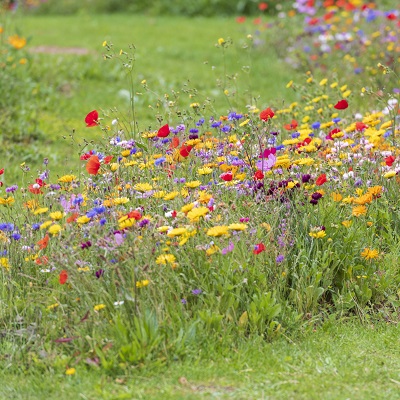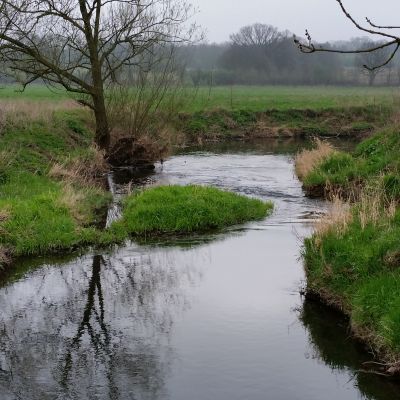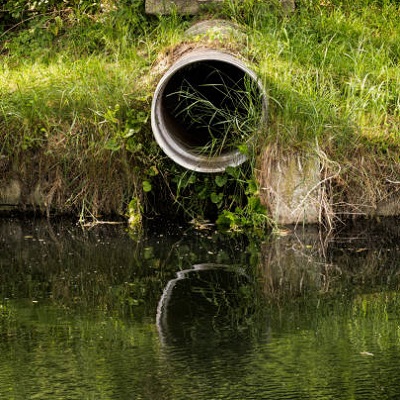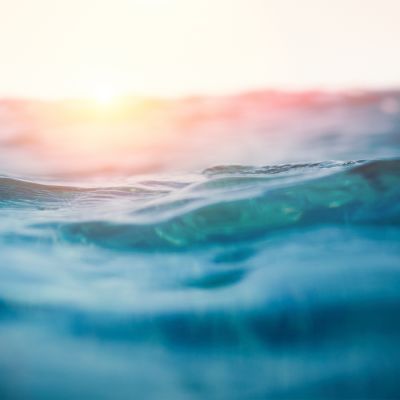Contact Dr Robert Grabowski
- Tel: +44 (0) 1234 758360
- Email: r.c.grabowski@cranfield.ac.uk
- Twitter: @BankfullScience
- ORCID
Areas of expertise
- Natural Capital
- Sustainable Land Systems
- Water Science and Engineering
Background
Dr Robert (Bob) Grabowski is an environmental scientist specialized in the interdisciplinary study of rivers. He applies a whole system perspective to tackle fundamental scientific and applied challenges at the interface of geomorphology, ecology, water quality, and integrated land-water management.
Bob's research group works on three main topics: 1) erosion and transport of fine sediment and sediment-bound contaminants, 2) geomorphology-ecology interactions in river - floodplain systems, and 3) river rehabilitation and restoration. This research spans spatial and temporal scales (nm - km) and uses a broad range of approaches, such as molecular dynamics simulations of interparticle attractions in sediment (EPSRC), statistical and time series analyses of suspended sediment dynamics in rivers, and field surveys to determine ecological responses to river processes and human interventions (EU). More recently, Bob has begun to link geomorphology processes in river/floodplains with social and economic issues to support the attainment of sustainable development goals (NERC) and the development of new participatory models of knowledge creation and governance (ESRC, AHRC). For more details, see the Current Activities section.
Bob received a BSc in Biology (Illinois Wesleyan University), an MSc in Marine Biology (University of Maine - Orono), and a PhD in Physical Geography (Queen Mary, University of London). He was a Research Fellow on the EU-funded project REFORM (Restoring rivers FOR effective catchment Management) before joining Cranfield as Lecturer in Catchment Science in 2014. He became Senior Lecturer in 2019 and Reader in 2023. He contributes actively to teaching in the Water & Jiangsu MSc programmes.
He is a member of the NERC Peer Review College (2023-present), the editorial board of River Research and Applications (2017-present), and the Foundation for Water Research Committee (2023-present). He is a Fellow of the Higher Education Academy (FHEA).
Research opportunities
For funded research opportunities, please see the University's current listing (https://www.cranfield.ac.uk/research/research-degrees/research-opportunities). Self-funded students or those with funding from their home country are invited to contact Bob to discuss their PhD or MRes research plans
The Water Science Institute welcomes visiting students and academics. If you are interested in a short internship or secondment and have funding to cover your travel and living expenses, please get in touch by email.
Current activities
Bob and researchers in his group are working on a range of topics in fluvial geomorphology, aquatic ecology and catchment science.
Current and recent projects:
- Riverbed biofilms as integrated indicators of ecological health (Funded by the UK Government, Water Restoration Fund, 2025-2026, PI)
- Connected Waters Leverhulme Doctoral Programme (Leverhulme Foundation, in partnership with Roehampton University, 2024 - 2032, co-Director)
- Sharing our knowledge: incorporating Indigenous knowledge systems to build governance for climate resiliency (UKRI - ES/Z000211/1, Canadian NFRF, 2024 - 2027, Co-Investigator)
- Defragmenting the fragmented urban landscape (DEFRAG) (Natural Environment Research Council - UKRI - NE/W003031/1, 2021-2025, Co-Investigator)
- The future of Rights of Nature: an interdisciplinary scoping analysis (Arts and Humanities Research Council - UKRI, AH/V00574X/1, 2020-2021, Co-Investigator)
- Improved prediction of cohesive sediment erosion based on inter-particle forces (Engineering and Physical Sciences Research Council - UKRI, EP/T001100/1, 2020-2022, Primary Investigator)
- Social, economic and environmental trade-offs in managing the land-river-interface (Natural Environment Research Council - UKRI, NE/S01232X/1, 2019 - 2022, Primary Investigator)
- HypoTRAIN: Hyporheic Zone Processes - A training network for enhancing the understanding of complex physical, chemical and biological process interactions (Marie Sklodowska-Curie Innovative Training Network, European Commission, 2015-2018, Institutional Lead)
Current research students
- Hannah Posner-Gafnfey - Socio-ecological synergies and trade-offs in river rewilding (PhD, Leverhulme Trust, 2025-2029)
- Neve Hughes - Exploring the legitimacy of river health monitoring (PhD, Leverhulme Trust, 2025-2029)
- Erin Doyle - Integrated indicators of river health (PhD, Leverhulme Trust, 2024-2028)
- Purnanjali Chandra - The hybridity of polluted rivers (PhD, Leverhulme Trust, 2024-2028)
- Lisa Donovan - Improving the functionality and accuracy of a Soil Erosion and Sediment Delivery Decision Support Tool (SESD-DST) and application to priority surface water catchments in England (PhD, 2023 - 2026)
- Ayisha Affo Souleymane - Phosphorus removal and carbon sequestration in surface flow treatment wetlands (PhD, Industry-sponsored, 2022-2026)
Previous research students
- Dr Jae hun Shin - Impacts of climate change of suspended sediment dynamics in rivers (PhD, 2020 - 2023). First position: KTP Associate, Cranfield University.
- Dr Ben Exton - Transport, fate and aquatic ecological impact of airport de-icers (PhD, Heathrow Airport, CENTA2 DTP, NERC, 2019-2023). First position: Research Associate, Cranfield University.
- Dr Katy Wiltshire - Tracing the origin of sediments and carbon across the terrestrial-aquatic continuum (PhD, STARS CDT, NERC/BBSRC, 2018-2022). First position: Research Associate, Cranfield University.
- Dr Selena Zang - Hydrological and contaminant transport modelling of permeable paving sustainable urban drainage systems (PhD, 2017-2021). First position: Civil Engineer, Arup.
- Dr Emily Dowdeswell - Feedback mechanisms on soil susceptibility to erosion processes in a changing climate (PhD, STARS CDT, NERC/BBSRC, 2016-2020). First position: Policy Advisor at the Department of Business, Energy, and Industrial Strategy (BEIS)
- Dr Charles Mazivanhanga - Near real-time correction of flood forecasting using high-resolution satellite data for multi-hazard risk assessment in lowland tropical regions (PhD, DREAM CDT, NERC/ESRC, 2016 - 2019)
- Dr Mickaël Dubois - Eco-hydromorphology applied to fish communities of chalk stream and management perspectives (PhD, Affinity Water and Environment Agency, 2016-2019)
- Dr Chiara Magliozzi - Hydroecological investigations on the hyporheic zone to support river management from reaches to catchments (PhD, Marie Sklodowska-Curie ITN, 2015-2018). First position: National Research Council of Italy CNR-Pisa
- Dr Kim Vercruysse - Processes controlling the sources and transport dynamics of suspended sediment in rivers (PhD, Arup and Leeds City Council, 2014-2017). First position: Postdoctoral researcher, University of Leeds
Clients
Affinity Water
Anglian Water
Arts and Humanities Research Council (AHRC - UKRI)
Atkins
Canal and River Trust
Cartographer
Cefas
Central Bedfordshire Council
Defra
Engineering and Physical Sciences Research Council (EPSRC - UKRI)
Environment Agency
European Commission (Marie Sklodowska-Curie ITN)
Heathrow Airport
IUCN
Jacobs
Leeds City Council / Arup
Luton Borough Council
Natural Environment Research Council (NERC - UKRI)
Mott MacDonald
Publications
Articles In Journals
- Wiltshire C, Meersmans J, Waine TW, Grabowski RC, Addy S, .... (2025). Understanding organic carbon dynamics in a river catchment through improved sediment fingerprinting. CATENA, 258
- Exton B, Hassard F, Medina A & Grabowski RC. (2025). Influence of temperature, sunlight and wind on the mobilization of propylene glycol from airport de‐icers by rainfall. Water and Environment Journal
- Liu A, Chen C, Chen K, Shi Y, Grabowski RC, .... (2024). Effects of parental exposure to amitriptyline on the survival, development, behavior, and gene expression in zebrafish offspring. Science of the Total Environment, 912
- Mazivanhanga C, Grabowski RC, Perez Sanchez E & Carballo Cruz VR. (2024). Analysis of scaling relationships for flood parameters and peak discharge estimation in a tropical region. Hydrology Research, 55(2)
- Exton B, Hassard F, Medina A & Grabowski RC. (2024). Undesirable river biofilms: the composition, environmental drivers, and occurrence of sewage fungus. Ecological Indicators, 161
- Wiltshire K, Meersmans J, Waine TW, Grabowski RC, Thornton B, .... (2024). Evaluating erosion risk models in a Scottish catchment using organic carbon fingerprinting. Journal of Soils and Sediments, 24(8)
- Wohl E, Fryirs K, Grabowski RC, Morrison RR & Sear D. (2024). Enhancing the natural absorbing capacity of rivers to restore their resilience. BioScience, 74(11)
- Exton B, Hassard F, Medina A & Grabowski RC. (2024). Impact of carbon sources in airport de-icing compounds on the growth of Sphaerotilus natans. Frontiers in Microbiology, 15
- Exton B, Hassard F, Medina A & Grabowski RC. (2023). Polybacterial shift in benthic river biofilms attributed to organic pollution – prospect of a new biosentinel?. Hydrology Research, 54(3)
- Wiltshire C, Waine T, Grabowski RC, Meersmans J, Thornton B, .... (2023). Assessing n-alkane and neutral lipid biomarkers as tracers for land-use specific sediment sources. Geoderma, 433(May)
- Gilbert J, Soliev I, Robertson A, Vermeylen S, Williams NW, .... (2023). Understanding the Rights of Nature: working together across and beyond disciplines. Human Ecology, 51(3)
- Shin JH, Grabowski RC & Holman IP. (2023). Indicators of suspended sediment transport dynamics in rivers. Hydrology Research, 54(8)
- Shin JH, Grabowski RC & Holman IP. (2023). Catchment and climatic influences on spatio-temporal variations in suspended sediment transport dynamics in rivers. Hydrology Research, 54(8)
- Dowdeswell-Downey E, Grabowski RC & Rickson RJ. (2023). Do temperature and moisture conditions impact soil microbiology and aggregate stability?. Journal of Soils and Sediments, 23(10)
- Yu S, Peng J, Xia P, Wang Q, Grabowski RC, .... (2023). Network analysis of water-related ecosystem services in search of solutions for sustainable catchment management: A case study in Sutlej-Beas River systems, India. Ecosystem Services, 63(October)
- Lyu T, Williams R, Exton B & Grabowski RC. (2023). Assessing the efficacy and mechanisms of glycol-contaminated water treatment through floating treatment wetlands. Water Science & Technology, 88(11)
- Wharton G, Phillips J, Legout C & Grabowski RC. (2023). Preface: understanding fine sediment dynamics in aquatic systems. Journal of Soils and Sediments, 23(10)
- Chen WL, Grabowski RC & Goel S. (2022). Clay swelling: role of cations in stabilizing/destabilizing mechanisms. ACS Omega, 7(4)
- Chen WL, Muller P, Grabowski RC & Dodd N. (2022). Green nourishment: an innovative nature-based solution for coastal erosion. Frontiers in Marine Science, 8
- Wiltshire C, Glendell M, Waine TW, Grabowski RC & Meersmans J. (2022). Assessing the source and delivery processes of organic carbon within a mixed land use catchment using a combined n-alkane and carbon loss modelling approach. Journal of Soils and Sediments, 22(5)
- Grabowski RC, Vercruysse K, Holman IP, Azhoni A, Bala B, .... (2022). The land-river interface: a conceptual framework of environmental process interactions to support sustainable development. Sustainability Science, 17(4)
- Wang X, Peng J, Luo Y, Qiu S, Dong J, .... (2022). Exploring social-ecological impacts on trade-offs and synergies among ecosystem services. Ecological Economics, 197(July)
- Vercruysse K, Grabowski RC, Holman IP, Azhoni A, Bala B, .... (2022). Place-based interpretation of the sustainable development goals for the land-river interface. Sustainability Science, 17(4)
- Beale J, Grabowski RC, Lokidor PL, Vercruysse K & Simms DM. (2022). Vegetation cover dynamics along two Himalayan rivers: drivers and implications of change. Science of The Total Environment, 849(November)
- Azhoni A, Holman IP & Grabowski RC. (2022). Identifying evolving priorities in national river governance from Parliamentary Questions. Water Policy, 24(9)
- Vercruysse K & Grabowski RC. (2021). Human impact on river planform within the context of multi-timescale river channel dynamics in a Himalayan river system. Geomorphology, 381(May)
- Chazdon RL, Falk DA, Banin LF, Wagner M, Wilson S, .... (2021). The intervention continuum in restoration ecology: rethinking the active-passive dichotomy. Restoration Ecology, 32(8)
- Cornacchia L, Wharton G, Davies G, Grabowski RC, Temmerman S, .... (2020). Self-organization of river vegetation leads to emergent buffering of river flows and water levels. Proceedings of the Royal Society B: Biological Sciences, 287(1931)
- Vercruysse K, Grabowski RC, Hess T & Lexartza-Artza I. (2020). Linking temporal scales of suspended sediment transport in rivers: towards improving transferability of prediction. Journal of Soils and Sediments, 20(12)
- Magliozzi C, Meyer A, Usseglio-Polatera P, Robertson A & Grabowski RC. (2020). Investigating invertebrate biodiversity around large wood: taxonomic vs functional metrics. Aquatic Sciences, 82(4)
- Lewandowski J, Arnon S, Banks E, Batelaan O, Betterle A, .... (2019). Is the hyporheic zone relevant beyond the scientific community?. Water, 11(11)
- Vercruysse K & Grabowski RC. (2019). Temporal variation in suspended sediment transport: linking sediment sources and hydro-meteorological drivers. Earth Surface Processes and Landforms, 44(13)
- Magliozzi C, Usseglio-Polatera P, Meyer A & Grabowski RC. (2019). Functional traits of hyporheic and benthic invertebrates reveal importance of wood-driven geomorphological processes to rivers. Functional Ecology, 33(9)
- Grabowski RC, Gurnell AM, Burgess‐Gamble L, England J, Holland D, .... (2019). The current state of the use of large wood in river restoration and management. Water and Environment Journal, 33(3)
- McAdam E, Grabowski R & Gurnell A. (2019). Editorial. Water and Environment Journal, 33(3)
- Vercruysse K & Grabowski RC. (2018). Using source‐specific models to test the impact of sediment source classification on sediment fingerprinting. Hydrological Processes, 32(22)
- Magliozzi C, Coro G, Grabowski RC, Packman AI & Krause S. (2018). A multiscale statistical method to identify potential areas of hyporheic exchange for river restoration planning. Environmental Modelling & Software, 111
- Magliozzi C, Grabowski RC, Packman AI & Krause S. (2018). Toward a conceptual framework of hyporheic exchange across spatial scales. Hydrology and Earth System Sciences, 22(12)
- Cornacchia L, Folkard A, Davies G, Grabowski RC, van de Koppel J, .... (2018). Plants face the flow in V-formation: a study of plant patch alignment in streams. Limnology and Oceanography, 64(3)
- Vercruysse K, Grabowski RC & Rickson RJ. (2017). Suspended sediment transport dynamics in rivers: Multi-scale drivers of temporal variation. Earth-Science Reviews, 166
- Marcinkowski P, Grabowski RC & Okruszko T. (2017). Controls on anastomosis in lowland river systems: Towards process-based solutions to habitat conservation. Science of The Total Environment, 609
- Grabowski RC & Gurnell AM. (2016). Diagnosing problems of fine sediment delivery and transfer in a lowland catchment. Aquatic Sciences, 78(1)
- Janes VJ, Grabowski RC, Mant J, Allen D, Morse JL, .... (2016). The impacts of natural flood management approaches on in-channel sediment quality. River Research and Applications, 33(1)
- Gurnell AM & Grabowski RC. (2016). Vegetation–Hydrogeomorphology Interactions in a Low‐Energy, Human‐Impacted River. River Research and Applications, 32(2)
- Gurnell AM, Corenblit D, García de Jalón D, González del Tánago M, Grabowski RC, .... (2016). A Conceptual Model of Vegetation–hydrogeomorphology Interactions Within River Corridors. River Research and Applications, 32(2)
- Grabowski RC & Gurnell AM. (2016). Hydrogeomorphology-ecology interactions in river systems. River Research and Applications, 32(2)
- Bizzi S, Demarchi L, Grabowski RC, Weissteiner CJ & Van de Bund W. (2016). The use of remote sensing to characterise hydromorphological properties of European rivers. Aquatic Sciences, 78(1)
- Gurnell AM, Rinaldi M, Belletti B, Bizzi S, Blamauer B, .... (2016). A multi-scale hierarchical framework for developing understanding of river behaviour to support river management. Aquatic Sciences, 78(1)
- Summers MF, Holman IP & Grabowski RC. (2015). Adaptive management of river flows in Europe: A transferable framework for implementation. Journal of Hydrology, 531
- Camenen B, Grabowski RC, Latapie A, Paquier A, Solari L, .... (2015). On the estimation of the bed-material transport and budget along a river segment: application to the Middle Loire River, France. Aquatic Sciences, 78(1)
- Grabowski RC, Surian N & Gurnell AM. (2014). Characterizing geomorphological change to support sustainable river restoration and management. WIREs Water, 1(5)
- Grabowski RC, Wharton G, Davies GR & Droppo IG. (2012). Spatial and temporal variations in the erosion threshold of fine riverbed sediments. Journal of Soils and Sediments, 12(7)
- Grabowski RC, Droppo IG & Wharton G. (2011). Erodibility of cohesive sediment: The importance of sediment properties. Earth-Science Reviews, 105(3-4)
- Grabowski RC, Droppo IG & Wharton G. (2010). Estimation of critical shear stress from cohesive strength meter-derived erosion thresholds. Limnology and Oceanography: Methods, 8(DECEMBER)
- Grabowski RC, Droppo IG & Wharton G. (2010). Estimation of critical shear stress from cohesive strength meter‐derived erosion thresholds. Limnology and Oceanography: Methods, 8(12)
- Grabowski RC, Windholz T & Chen Y. (2005). Estimating exploitable stock biomass for the Maine green sea urchin (Strongylocentrotus droebachiensis) fishery using a spatial statistics approach. Fishery Bulletin, 103(2)
- Grabowski R & Chen Y. (2004). Incorporating uncertainty into the estimation of the biological reference points F0.1 and Fmax for the Maine green sea urchin (Strongylocentrotus droebachiensis) fishery. Fisheries Research, 68(1-3)
Conference Papers
- Chen W, Grabowski RC & Goel S. (2022). Modelling short-range interaction of clay particles to improve erodibility prediction
- Wiltshire C, Waine T, Grabowski RC, Glendell M, Thornton B, .... (2022). Assessing the source and delivery of organic carbon at a catchment scale using a combined sediment fingerprinting and carbon loss modelling approach
- Vercruysse K & Grabowski RC. (2021). Quantifying how hydrological and geomorphical dynamics in the land-river interface create opportunities and trade-offs for sustainable development
- Wiltshire C, Glendell M, Waine T, Grabowski RC, Thornton B, .... (2021). From field to stream: Tracing streambed organic carbon origins at a catchment scale
- Kregting LT, Yund PO, Thomas FIM & Grabowski RC. (2006). Position, distance and hydrodynamic effects an fertilization success of the green sea urchin Strongylocentrotus droebachiensis.
- Thomas FIM, Badgley BD, Yund PO & Grabowski RC. (2005). Linking field measurements of hydrodynamic conditions to the fertilization of the green sea urchin Strongylocentrotus droebachiensis
Books
- Grabowski RC & Gurnell AM. (2016). Using historical data in fluvial geomorphology In Kondolf GM & Piegay H (eds), Tools in Fluvial Geomorphology Second Edition. Wiley.
- Gurnell AM, González del Tánago M, Rinaldi M, Grabowski R, Henshaw A, .... (2015). Development and Application of a Multi-scale Process-Based Framework for the Hydromorphological Assessment of European Rivers In Lollino G, Arattano M, Rinaldi M, Giustolisi O, Marechal JC, ... (eds), Engineering Geology for Society and Territory - Volume 3 (Volume 3). Springer International Publishing.
- Grabowski RC. (2014). Measuring the shear strength of cohesive sediment in the field In Clarke L & Nield J (eds), Geomorphological techniques (Online). British Society for Geomorphology.










